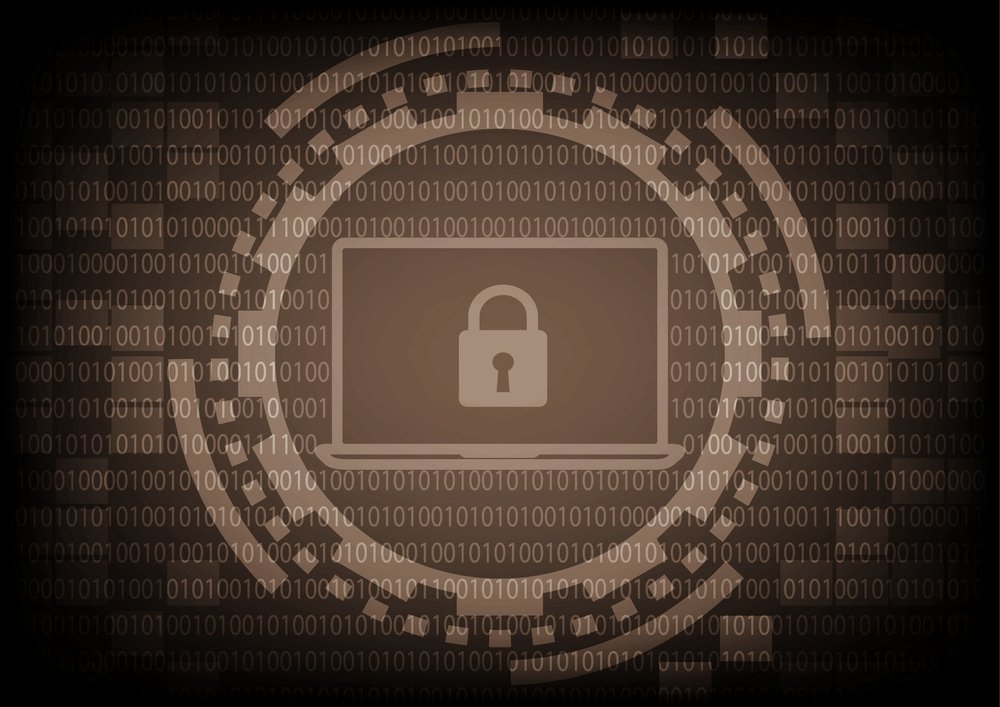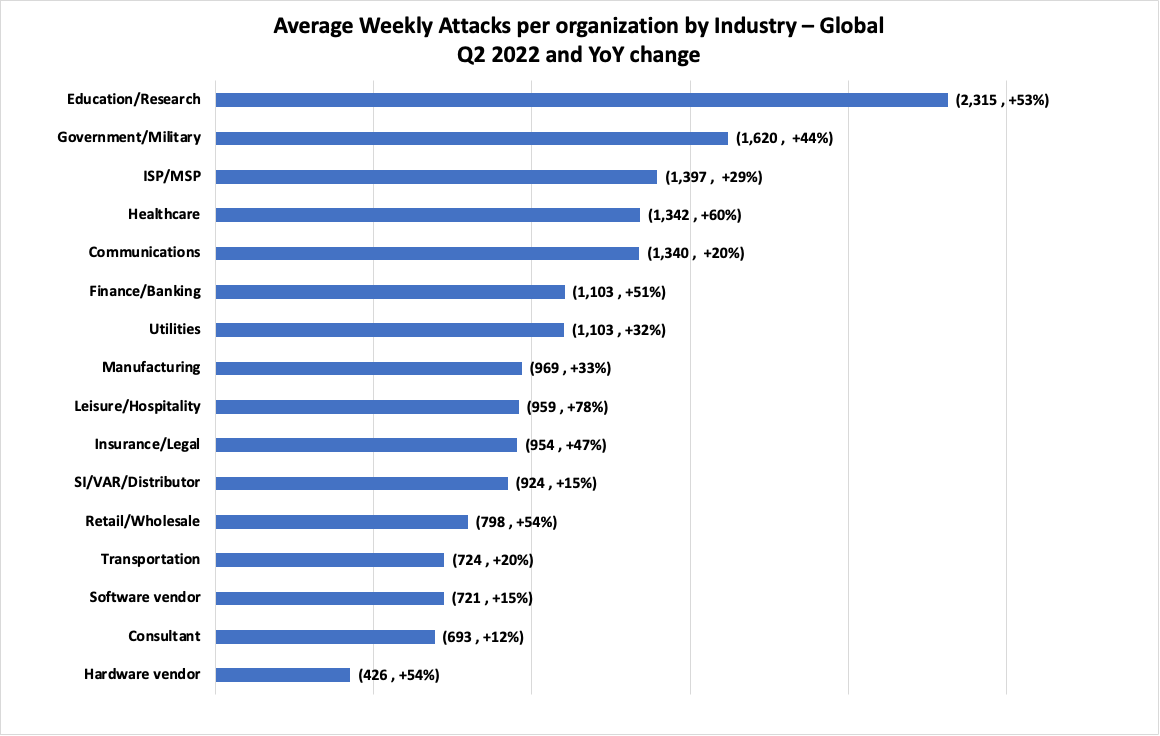Η Check Point Research (CPR) δημοσιεύει νέα δεδομένα σχετικά με τις τάσεις των επιθέσεων στον κυβερνοχώρο. Οι attacks ransomware now affects 1 in 40 organizations per week.
The top three industries most targeted by ransomware are government/military, education/research, healthcare. High geopolitical tensions, the rise of remote work and education, and organizations' willingness to pay have led to a 59% year-over-year increase in ransomware attacks.

CPR also presents overall cyber attack trends, including overall cyber attacks by industry and region.
The second quarter of 2022 saw an all-time high, where global cyber attacks increased by 32%, compared to the second quarter of 2021, and the average weekly attacks per organization reached a peak of 1,2 thousand attacks.
• The retail and wholesale sector saw the biggest increase in ransomware attacks, with an alarming 182% increase
• The government/military sector saw a staggering 135% increase, reaching a ratio of 1 in 24 organizations affected by ransomware on a weekly basis
• The Education/Research sector has become the most attacked industry globally, absorbing an average of more than 2,3K attacks per organization each week, a 53% increase compared to Q2021 XNUMX
Check Point Research (CPR) publishes new data on cyber attack trends. In a new report, CPR shares that the global weekly average of organizations affected by ransomware now stands at 1 in 40 – a 59% year-over-year increase (1 in 64 organizations in Q2021 XNUMX).
Ransomware by region
The areas that receive the most cyber attacks are:
• Africa: weekly average of organizations affected is 1 in 21 – up 21% year-on-year (1 in 25 organizations in Q2021 XNUMX)
• Europe: weekly average of affected organizations is 1 in 66 – down 1% year-on-year (1 in 65 organizations in Q2021 XNUMX)
• North America: the weekly average of affected organizations is 1 in 108 – a slight increase of 1% year-on-year (1 in 109 organizations in Q2021 XNUMX)
• ANZ: weekly average of organizations affected is 1 in 113 – up 18% year-on-year (1 in 133 organizations in Q2021 XNUMX)
Η Latin America has seen the biggest increase in attacks, finding 1 in 23 organizations affected weekly, a 43% year-on-year increase, compared to 1 in 33 in the second quarter of 2021, followed by Asia which has seen a 33% year-on-year increase, reaching 1 in 17 organizations affected weekly.
Ransomware by industry
The retail and wholesale sector saw the biggest rise in ransomware attacks, with an alarming 182% increase compared to the same period last year, followed by the Distributors sector which saw a 143% increase.

Next, the government/military sector, reports a staggering 135% increase, reaching a ratio of 1 in 24 organizations affected by ransomware on a weekly basis.
|
Industry |
Weekly Impacted Organizations |
YoY Change |
|
Government/Military |
1 24 out of |
+ 135 % |
|
Education/Research |
1 30 out of |
+ 83 % |
|
Healthcare Logistics |
1 31 out of |
+ 47 % |
|
ISP / MSP |
1 37 out of |
+ 9 % |
|
Finance/Banking |
1 41 out of |
+ 42 % |
|
Communications |
1 46 out of |
+ 59 % |
|
SI/VAR/Distributor |
1 47 out of |
+ 143 % |
|
Manufacturing |
1 48 out of |
+ 60 % |
|
Retail/Wholesale |
1 53 out of |
+ 182 % |
|
Utilities |
1 59 out of |
+ 11 % |
|
Transportation |
1 70 out of |
+ 28 % |
|
Software vendor |
1 74 out of |
-34% |
|
Leisure/Hospitality |
1 77 out of |
+ 24 % |
|
Hardware vendor |
1 78 out of |
+ 48 % |
|
Insurance/Legal |
1 81 out of |
+ 1 % |
|
Consultant |
1 87 out of |
-17% |
Cyber attacks by industry
The Education/Research sector has become the most attacked industry globally, absorbing an average of more than 2,3 thousand attacks per organization each week, a 53% increase compared to Q2021 XNUMX.
The healthcare sector saw a 60% increase in cyber attacks compared to the second quarter of 2021, reaching 1342 attacks per organization each week.
Cyber attacks per area
Africa was the most attacked region in the second quarter of 2022, with 1,76 thousand weekly attacks on average, per organization, a nominal increase of 3%, compared to the same period last year against the continent. After Africa, Asia and Latin America posted impressive numbers of 1,68k and 1,60k on average respectively, up 25% and 29% respectively, year-on-year.
|
Region |
Weekly Attacks |
YoY Change |
|
Africa |
1,758 |
+ 3 % |
|
Asia |
1,684 |
+ 25 % |
|
Latin America |
1,602 |
+ 29 % |
|
Europe |
963 |
+ 26 % |
|
ANZ |
937 |
+ 82 % |
|
North America |
854 |
+ 54 % |
Comment by Omer Dembinsky, Data Group Manager at Check Point Software:
“Ransomware attacks show no signs of slowing down. Right now, we can say that 1 in 40 organizations we monitor are affected by ransomware every week, which translates to a 59% year-over-year increase. Hackers are taking advantage of the increased attack surface afforded by remote work and education. In addition, the war between Ukraine and Russia is helping to grow the trend, as rising geopolitical tensions inspire hackers to take sides. Finally, organizations' willingness to respond to ransomware demands in order to protect patients has proven that the ransomware business is highly profitable. Therefore, we see that hackers continue to invest e.gconditions to pursue health care organizations. We strongly recommend that organizations everywhere consider our ransomware prevention tips, such as backing up data, updating systems and educating employees about awareness.”
Ransomware attack prevention tips
1. Back up your data. Make sure you back up your data regularly — continuously, if possible, and across the organization
2. Be proactive. It's worth putting together a response strategy. In other words, what are you going to do if your organization becomes the target of a ransomware attack?
3. Use content scanning and filtering. A common method for ransomware attackers is to trick employees into either giving their login credentials via a phishing link or downloading a file containing malicious software. You can protect yourself from both of these potential threats by applying more content scanning and filtering.
4. Keep your systems up to date. Make sure you keep your systems up to date with the latest software patches.
5. Train your employees. Ransomware attacks are often the result of poor employee training and/or bad employee habits. Make sure your employees are familiar with standard best practices in the cybersecurity world, such as choosing strong passwords, not sharing their passwords with others, and avoiding links and content that look suspicious or unfamiliar.





